Those who participated in the March on Washington for Jobs and Freedom in 1963 include more than two dozen current members of the PSC. Two-thirds of them returned to Washington on August 24, 2013, to mark the 50th anniversary of the March on Washington by joining another massive demonstration for racial justice. Some traveled to DC on their own, others on one of four buses sponsored by the PSC. Clarion spoke with PSCers about the two historic events and the changes they’ve experienced in between. Some comments reflect the bitter civil rights conflicts they’ve been part of; though it may be difficult to hear, we’ve left the words unchanged.
 |
Tony Young
Adjunct Assistant Professor
Hunter School of Social Work
Tony Young grew up in Panama in the 1950s in a sharply segregated society that emulated the racial caste system of the American South. His family moved to Brooklyn in 1958 when Tony was ten, where he once again found himself living in a neighborhood segregated by race and class. When Young traveled with an uncle to the 1963 March on Washington, he caught a glimpse of a different kind of society.
“I had never seen such true multiculturalism,” Young recalled. “What this nation should be about was present that day.”
Despite the heat and the discomfort of standing for hours, Young was present for the final speech of the day by Dr. Martin Luther King, Jr.
“He fed off the energy of the crowd and delivered a great speech,” Young said. “He was telling us to go home and do the work that needs to be done.” While King’s soaring call for interracial harmony is what is most remembered about the speech, Young noted that the civil rights leader also focused on concrete objectives such as jobs and voting rights. “He was not just pie-in-the-sky, ‘I Am a Dreamer.’ It was a political speech that spoke about politics and legislation.”
King’s later outspoken opposition to the US war in Vietnam helped inspire Young to become a conscientious objector while he was a student at Queens College. For his alternative service, he did employment counseling for youth and worked with heroin users being treated for addiction. That was the beginning of his career in social work.
Young currently heads a management consulting firm that assists non-profits. He has also taught as an adjunct at the Hunter School of Social Work for 20 years. “When I teach my students, I tell them you have to understand context, that everything is connected,” said Young.
Looking back on the 2013 March, Young said he was disappointed that more of the attendees couldn’t get on the National Mall or hear the speakers. But the strong turnout was important, he added. “We have to keep talking and sharing the legacy so we can pass the torch.”
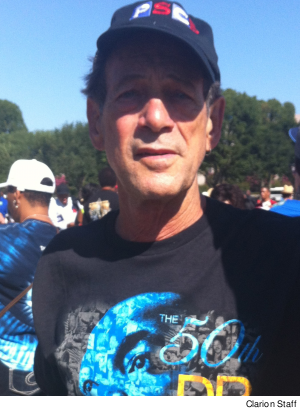 |
Alan Feigenberg
Professor of Architecture
City College of New York
When Alan Feigenberg arrived in Washington, DC, on August 28, 1963, he was a junior at the University of Pennsylvania who had been peripherally involved in civil rights activism on his campus. For Feigenberg, who was 19 at the time, the size of the crowd and the marchers’ combination of generosity and determination were deeply moving.
“There was hope and optimism for the future,” he told Clarion. “It had a major impact on me.”
Back at Penn, Feigenberg deepened his involvement in a local campaign to require that construction jobs for a campus expansion be open to both white and African-American workers. Where before he had been content to sign a petition, he was now a regular presence on picket lines organized by the Philadelphia NAACP outside construction sites and he joined a sit-in in the university president’s office.
“It was the first time I really felt like I was committing myself to something,” said Feigenberg, who recalled being heckled by other white students as a “nigger-lover” and a “sellout.”
Feigenberg’s commitment to social justice has continued over the decades. As a graduate student in architecture at Columbia University, he played a leading role in the 1968 student takeover of the campus that was triggered in part by the school’s discriminatory treatment of the residents of the adjacent Morningside Heights neighborhood. He subsequently worked for the city designing community centers and health clinics in low-income communities before joining the CCNY faculty in 1981.
“I have found my place where my professional work, my academic work and my political life are fully integrated,” said Feigenberg, who serves as PSC chapter chair at City College.
Feigenberg said he was “re-inspired” by the 2013 March on Washington. “This wasn’t a trip down memory lane. This was a new commitment,” he added. “Now that I have three grandchildren, I feel like I have even more of a vested interest in change.”
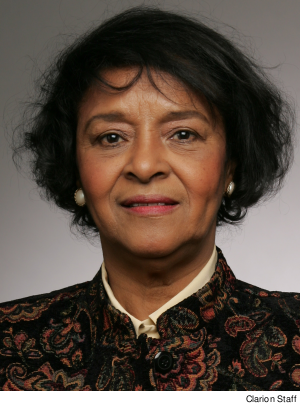 |
Angeline Butler
Adjunct Lecturer in Africana Studies
John Jay College
The civil rights movement had a profound impact on the 1960s. But at the onset of the decade. Southern segregationists were refusing to budge and winning Congressional approval of meaningful civil rights legislation seemed impossible.
Then small groups of young people, including Angeline Butler, began to take action that changed everyone’s sense of what could be done – defying segregation by sitting in at lunch counters across the South.
The first lunch counter sit-in to get widespread media attention was in Greensboro, North Carolina, on February 1, 1960. Organizing for similar actions in Nashville, where Butler lived, was already underway, and Butler was among those training in the techniques of Gandhian nonviolence.
Nashville college students led their first major lunch counter sit-ins on February 13, 1960, and a wave of others followed. After being attacked by white thugs, Butler and more than 80 other young people were arrested and hauled off to jail.
“I could not not join in this work, because I cared about my future,” Butler tells Clarion today. The sit-in movement spread rapidly across the South, and by April of that year, Butler and other young activists from the region formed the Student Nonviolent Coordinating Committee (SNCC). Butler later played a key role in coordinating the 1961 Freedom Rides from Nashville.
Upon receiving a scholarship to the Juilliard School of Music, Butler moved to New York where she cut an album of folk songs inspired by the civil rights movement and helped canvass people to attend the March on Washington. On the big day, Butler stood on the platform off to the side of the podium, next to baseball star Jackie Robinson, whom she had befriended several years earlier after she was arrested at a sit-in in Miami.
“I have been on so many marches in my life. It was one more march,” Butler said looking back on her trip to DC in 1963. Fifty years later, Butler returned to Washington for the commemoration with a sense of unfinished business. “We don’t have enough jobs,” said Butler. “We don’t have enough justice.”
Butler’s wide-ranging career as a singer, actress and teacher has included various television roles, stage performances from NYC’s Public Theater to Ireland, singing with the Duke Ellington and Count Basie bands, appearances on The Tonight Show and The Dick Cavett Show, earning a master’s in ethnomusicology at Columbia, and teaching at BMCC, in the California State University system and in the NYC public schools with the Lincoln Center Artist in Residence program. She began teaching Africana Studies at John Jay in 2005.
To this day, Butler says, she remains in touch with old SNCC comrades including Rep. John Lewis and former Georgia State Senator Julian Bond.
“We never left each other. We are still in touch,” Butler told Clarion. “It’s a life journey.”
Joan Gregg
Professor at City Tech
(Retired)
Joan Gregg boarded one of the four PSC busses heading to the 50th anniversary commemorative March on Washington well before sunrise. She was one of two “legacy marchers” on the bus and was invited to share her experiences from the original 1963 March. Younger marchers on the bus followed her and spoke about the urgent issues of today – lack of jobs and economic opportunity, stop-and-frisk, the shooting of Trayvon Martin – that they want to see addressed.
“That was so inspiring,” said Gregg who traveled to the 1963 March months after she had participated in a voter registration drive in the Jacksonville, Florida area with her sister and her brother-in-law.
“Parts of the South were one step up from slavery,” Gregg said, recalling the poverty and the isolation of African Americans she met who were living in wood shacks and faced a series of legal hurdles if they tried to assert their right to vote.
“The March wasn’t as much about the Dream Thing,” Gregg told Clarion as it was about “overturning some of those horrible things in the South.”
A native New Yorker, Gregg was a public school teacher at the time pursuing post-graduate studies in medieval literature at NYU. She would go on to protest the Vietnam War many times with her young children in tow. Gregg taught English (CK) at City Tech for 30 years before retiring in TK.
“To me, being a teacher means you are doing the work of the just,” said Gregg who also published a book (Devil, Women and Jews: Reflections of the Other in the Medieval Sermon Series) on medieval folk narratives that provide the basis for misogynist and anti-semitic views that exist to this day.
While Gregg says she is pleased to have seen evils like legalized segregation disappear, she says is “scared stiff” about the presence of a strong, well-funded Conservative movement in this country and whether a younger generation burdened with student loans and bleak job prospects can be politically active enough to carry the struggle forward.
“They are so stressed out,” Gregg observed, “but you have to do something.”
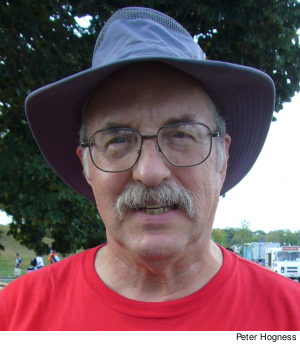 |
Wally Rosenthal
Continuing Education Teacher
Queensborough Community College
Wally Rosenthal’s mother was an anti-nuclear peace activist and his older brothers joined early civil rights protests in New York in support of the lunch counter sit-in movement that swept through the South in 1960. Such activism was expected in his postwar Jewish household in Queens, where the rise of Nazism in Germany and the Holocaust that followed were seen as a lesson in what happens when good people fail to stand up against evil.
When the call for the March on Washington went out, Rosenthal, then 16, responded and was present at the demonstration, along with 250,000 other people.
“The numbers, the energy, the sense of power in those numbers. That’s the lasting memory,” Rosenthal told Clarion. “It infused in me a sense of wanting to do something and feeling the potential that we could do something.”
Rosenthal joined a student chapter of the Congress on Racial Equality (CORE) and the following spring participated in sit-ins the group held on the opening day of the 1964 World’s Fair to protest the misuse of public funds that could have been spent on housing, health care and education.
Since then, Rosenthal’s activism has taken a variety of forms: first as a member of Students for a Democratic Society (SDS) at Queens College and later at the US Postal Service where he worked for 31 years and was active in the American Postal Workers Union and its New York Area chapter. In 2003, Rosenthal began teaching literacy classes to GED students at Brooklyn College. Since 2011, he has taught remedial math in the College Start program at QCC.
“I like the dynamic of working with young people and helping them break the academic chains that surround them,” Rosenthal said.
Rosenthal joined the PSC contingent at the 2013 march. Racism is not a relic of the past, he says, and coming out to protest on the 50th anniversary was one way to make his voice heard.
“This cancer of racism is alive and well in our society. There’s a humongous need for anything we can do to stop it,” he said.
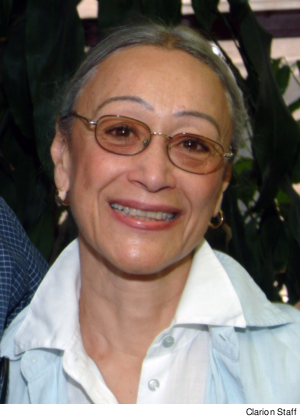 |
Cecilia McCall
Professor of English, SEEK Program Director Baruch College
When the media today looks back at the civil rights movement in the 1960s, it tends to focus, sometimes narrowly, on the South. But the North was also a site of struggle, including New York City. In the spring of 1969, the old Board of Higher Education acceded to demands for open admissions at CUNY, opening the doors to a university system that had to that moment a disproportionately white student body.
Six years earlier, Cecilia McCall had moved to New York after completing college. She soon became involved in local civil rights activism through a church-based group in Brooklyn. McCall traveled to the March on Washington with the group and found the mood of the day to be “uplifting.”
“I had a sense that something could be done,” she said. “People felt that things really could change.”
McCall taught for a year at a public school in Fort Greene, Brooklyn, and then worked with youth through government sponsored anti-poverty programs. Upon learning of the changes afoot at
CUNY, McCall joined the faculty at Baruch in 1969 as an instructor in the SEEK Program, which was created to provide assistance to students who are working-class, black and Latino, coming into CUNY as a result of open admissions.
CUNY tuition was free at the time, and SEEK students received additional stipends so they could focus on their studies and not have to work. They also received extensive academic counseling and remedial instruction. “All of us in the program wanted to be there,” McCall said. “These were the students we wanted to serve.”
McCall said the number of SEEK students began declining after tuition was imposed for the first time in 1976 in the wake of City’s fiscal crisis. In the following years, more austerity led to additional funding cuts for stipends and the support services offered to SEEK students.
After Matthew Goldstein became Chancellor in 1999, she said, SEEK was largely dismantled, leaving only the academic counseling part of it intact.
As a faculty member and an activist within the CUNY system, McCall has been involved in countless struggles to defend and expand CUNY’s funding, to press the administration on affirmative action in hiring, and to fight for students’ interests in struggles over remedial instruction and tuition. Serving as PSC secretary and its legislative director from 2000 until she retired in 2006, she brought a new level of organization and impact to the PSC’s political work and its grassroots lobbying.
McCall took part in this year’s March on Washington demonstration as a part of the PSC contingent, and has been actively involved in the union’s work on the 2013 City elections. Looking back over five decades, she says the main lesson she’s learned is that the struggle must continue. “If you give up, there’s no hope,” McCall said. “As long as you keep on struggling, there’s a possibility of change.”
Yinka Stanford
Adjunct Lecturer
City University of NY
In 1963, Yinka Stanford was a teenager and a newly arrived immigrant from the Eastern Caribbean living with her family in the Bronx. The early 1960s saw her on picket lines and at protests in New York City as a member of the Bronx Youth chapter of the Congress of Racial Equality (CORE).
Stanford traveled to the March on Washington on a bus sponsored by CORE. The day left her with many vivid memories: her first trip to the nation’s capital, the multitudes of people gathered for a common purpose, hearing Dr. Martin Luther King speak at the rally’s end.
“His booming voice with that southern cadence – no one else had that,” Stanford recalled. “The words and the delivery of “I have a Dream” speech were very inspiring. At the end, I remember everyone holding hands and singing ‘We Shall Overcome’.”
Stanford says that civil rights legislation barring discrimination in voting rights, jobs, housing, public accomodation, protections for individuals with disabilities and other areas of life is the most significant legacy of the movement, and that it has changed many lives in both north and south. “The body of civil rights law that came out of the African American Civil Rights Movement have benefitted so many indivuals who have used those laws to seek redress of grievances.”
In the years after the 1963 March, Stanford went on to complete college and worked as an administrator in City government. She later worked in private industry, taught in the New York City Department of Education High Schools Division and is now semi-retired. One of the milestones of her career as an educator is having taught in various CUNY colleges for many years (as an interdisciplinary adjunct lecturer (CUNY Reading Assessment Skills, GED Test Prep, Critical Thinking Skills in Reading and facilitated cooperative education seminars), GEAR Up mentor, academic counselor and as a faculty advisor for cooperative education students).
“The latter part of my career has been the most satisfying. I enjoy seeing students overcome the academic challenges they may face and feel excited about learning,” said Stanford who credits the civil rights movement for pushing CUNY to adopt an open admissions policy in 1969.
Stanford traveled with a PSC contingent to the 2013 March. Though the thick crowds and slow Metro service in D.C prevented her from hearing the program, she called her return experience “a milestone in my advocacy and activism.”
She said she found the presence of a younger generation at the commemorative march to be a hopeful sign. “Many of the youth who participated in the March recently were eager to become part of a historical event that a member of their family [may have] participated in 50 years ago,” Stanford said. “I believe that they are also conscious of the fact that the struggle continues.”
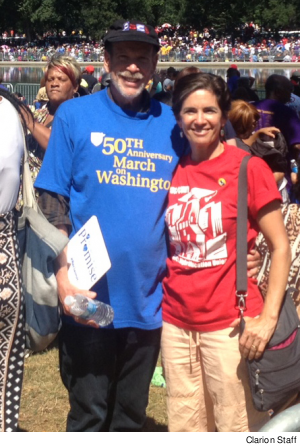 |
Gerald Markowitz
Distinguished Professor of History
John Jay College
Gerald Markowitz and four of his friends drove through the night to attend the 1963 March on Washington. Passing through Maryland, the racially mixed group realized they would have to continue on to Washington without stopping.
“There was no place to get out and eat,” Markowitz recalled. “Most restaurants were still segregated in that state.”
Arriving at the Washington Monument shortly after sunrise, Markowitz and his friends napped on nearby benches. They awoke to watch the crowd swell throughout the morning to epic proportions.
“We had a feeling this was something extraordinary,” said Markowitz, a native New Yorker who was then an undergraduate at Earlham College. “It was a beautiful, integrated crowd. It was the physical embodiment of what the civil rights movement was trying to achieve.”
Looking back 50 years later, Markowitz sees the ’63 march in many ways as being a high point for the civil rights movement. The gains of those years ushered in “fundamental changes” in American life, he said, but left economic underpinnings of racism unresolved.
“Issues of race and poverty were not going to be so easily solved as desegregated lunch counters in the South,” said Markowitz, who has co-authored a number of books and reports on the politics of occupational safety and health, including racial inequalities in safety on the job.
Markowitz traveled to the 2013 march with the PSC. He said he was impressed by the presence of speakers like Congressperson John Lewis (D-Ga.) – an early leader of the Student Nonviolent Coordinating Committee – and Myrlie Evers-Williams, widow of slain civil rights leader Medgar Evers, after whom CUNY’s Medgar Evers College is named. The size and the determination of the crowd to fight for equality for all Americans was inspiring this year, Markowitz said, but he missed the singing and music that was a hallmark of the civil rights movement in the 1960s.
“The expectation in 1963 was that things were going to get better,” Markowitz said. “Today, people are trying to preserve gains that we thought were permanent.”
______________________________
RELATED COVERAGE
Viewpoint: Fruits of Colorblindness

